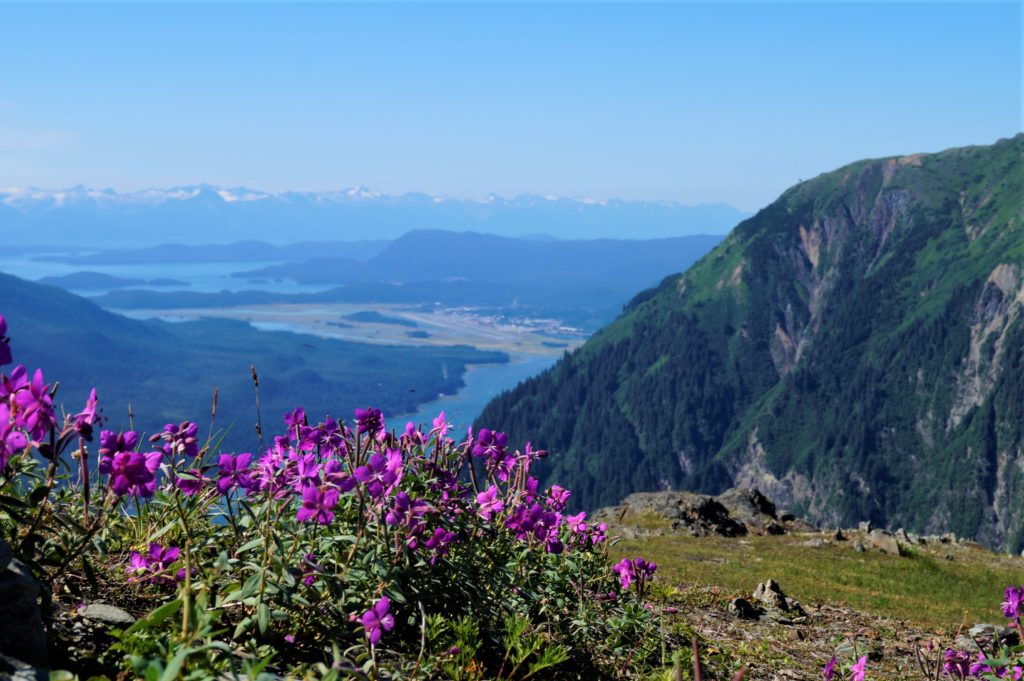
Whereas we walk thorough a meadow and see a cornucopia of colorful flowers, hundreds of years ago, Alaska’s indigenous people saw a grocery, a pharmacy, as many native plants are edible and have medicinal properties and uses.
***
Many visitors travel to Juneau with the hope of seeing glaciers, bears, whales and salmon. We often experience these wonders on Gastineau Guiding Company’s (my employer) Alaska Whales and Rainforest Trails and Photo Safari excursions. However, not expected, but surprisingly savored by our guests, are the enchanting wildflowers that punctuate the endless green landscape of Alaska’s Tongass National Forest. The Tongass is part of the largest temperate rainforest in the world, a swath of biomass that stretches from Northern California into the Kodiak Archipelago of Southcentral Alaska.
Although the springtime adage, “April showers bring May flowers” may be the case in much of North America, this observation is not true in Juneau. Indeed, Juneau receives profuse precipitation, but April temperatures are hardly spring-like, ranging only between 35°F to 49°F degrees (2°C to 10°C). May temperatures historically range between 42°F to 57°F degrees (6°C to 14°C), also low compared to more southerly regions. Therefore, I believe it is not rain, but daylight that triggers the spring eruption of wild flowers across the Tongass National Forest in late May. By mid-June, Juneauites are experiencing about 18 hours per day of daylight; daylight that spurs wildflowers to spring forth.
While June offers a cornucopia of wildflower blooms, one can enjoy a rainbow of wildflower colors into early fall, whether it is the petite presence of a forget-me-not in June or the mesmerizing magenta of our fireweed fields in August.
Let me backtrack. Ordinarily, sea-level fireweed blooms in August, but this year (July, 2019) it is already in full bloom. I believe its early appearance may a result of the high-70s and lower-80s degrees days of full sunshine we experienced in the last week of June. Very, very, very unusual. Based on its past history, there is a saying, “when the fireweed turns to cotton, summer will soon be forgotten,” – meaning winter is 6 to 8 weeks away. Hmmmm! Winter in August?
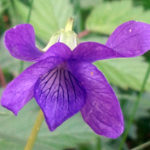
Alaska Violet: This beauty thrives in Southeast Alaska’s coastal meadows and blooms April to August. Very high in Vitamin C, its leaves and variable blue to purple flowers are best harvested in spring to early summer. The young flowers and leaves are a healthy, colorful addition to salads or eat the flower as a fresh snack while hiking. Also add the flower to casseroles, gelatin salads and desserts, and candied for cake decorations. Violet flower tea and syrup make a gentle laxative. Infuse the blossoms with water for a traditional eye wash. Due to their skin-softening properties, violets are often an added ingredient in body lotions. I have seen this violet nestled in the meadow just above Gastineau Guiding Company’s Nature Center on Mt. Roberts and at the Point Bridget meadow.
Beach Pea: Grows in beach gravel from Southern California to the Arctic 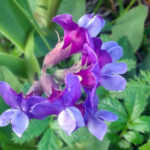 Ocean, across most of Canada, and many Northern US States. Blooms May to August. Young shoots are edible. The whole pea pod is edible if harvested early. You can also shuck the peas of older pods and eat them raw, boiled, steamed, stir-fried or sautéed. Not all wild peas are edible so positively identify your peas before injecting them. This potent purple pretty is found along the upper reaches of Sandy Beach on Douglas Island as well as the City’s North Douglas Trail beach.
Ocean, across most of Canada, and many Northern US States. Blooms May to August. Young shoots are edible. The whole pea pod is edible if harvested early. You can also shuck the peas of older pods and eat them raw, boiled, steamed, stir-fried or sautéed. Not all wild peas are edible so positively identify your peas before injecting them. This potent purple pretty is found along the upper reaches of Sandy Beach on Douglas Island as well as the City’s North Douglas Trail beach.
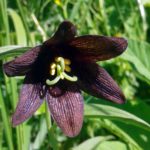 Chocolate Lily AKA Indian Rice: The dark purple to brown flower turns off most of us, but its unsavory aroma attracts a pollinating fly. Color and/or smell are nature’s means for attracting pollinators. Abundant in moist coastal-near meadows, including sub-alpine meadows, this lily has been a food source for Southeast Alaska’s indigenous people for eons. This lily’s roots resemble a sticky rice ball when harvested, however the chocolate lily is beautiful to behold, but stinky to smell. Its musky scent may fall after the flower dies out when the roots are storing starch and sugar. The root ball is prepared and eaten in much the same way rice is prepared. Voles enjoy eating them as well.
Chocolate Lily AKA Indian Rice: The dark purple to brown flower turns off most of us, but its unsavory aroma attracts a pollinating fly. Color and/or smell are nature’s means for attracting pollinators. Abundant in moist coastal-near meadows, including sub-alpine meadows, this lily has been a food source for Southeast Alaska’s indigenous people for eons. This lily’s roots resemble a sticky rice ball when harvested, however the chocolate lily is beautiful to behold, but stinky to smell. Its musky scent may fall after the flower dies out when the roots are storing starch and sugar. The root ball is prepared and eaten in much the same way rice is prepared. Voles enjoy eating them as well.
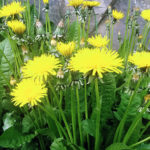 Dandelion
Dandelion
One gardener’s weed is another gardener’s flower. These showy “flowers” are the first abundant color to burst forth in early spring in Southeast Alaska. All of this plant is edible and many Alaskans harvest dandelions for salads and the flowers for wine, jelly and even coffee. Dandelion greens can be eaten raw, steamed, boiled, 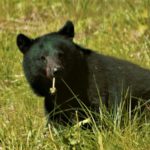 sautéed or braised. To make dandelion coffee, roast the roots for four hours or until dark brown and cracking. Then grind them and prepare as you would regular coffee. Full of antioxidants. Dandelions are a spring delicacy for black bears. Check out this fun video on dandelions on KTUU TV. Native to Europe, they are widespread throughout North America on lawns, pastures, meadows, roadsides and fields.
sautéed or braised. To make dandelion coffee, roast the roots for four hours or until dark brown and cracking. Then grind them and prepare as you would regular coffee. Full of antioxidants. Dandelions are a spring delicacy for black bears. Check out this fun video on dandelions on KTUU TV. Native to Europe, they are widespread throughout North America on lawns, pastures, meadows, roadsides and fields.
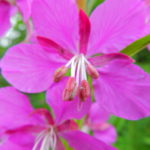 Fireweed & Dwarf Fireweed
Fireweed & Dwarf Fireweed
Found throughout much of Alaska, there are many species of this wildflower and all are edible. This native is a staple in many Alaskan kitchens and harvested annually as its fall flower buds and flowers make a flavorful jelly, honey and tasty tea. Spring shoots are edible as are late spring leaves (best before flowering). Its asparagus-like stalks are high in vitamin C and A and can be eaten raw, steamed or stir-fried. Medicinal uses include fireweed tea for calming an upset stomach or constipation and a dried powered root paste blended with petroleum jelly for soothing insect-bites and skin abrasions. Gastineau Guiding Company’s Nature Center on Mt. Roberts sells fireweed tea, honey and jelly made from the flower.
We see this dwarf version of this brilliant beauty in the tree-line meadows of Mt. Roberts during our Town, Tram and Timberline Trek excursion. In fact, all of our excursion guests will see fireweed as its flowers burst forth in late summer in recently disturbed areas, along the roadside or one of its most scenic locations, the Brotherhood Bridge pullout.
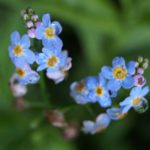 Forget-Me-Not: Petite, but hugely enjoyed and appreciated, the Forget-Me-Not is the Alaska State Flower. It grows well throughout Alaska and belongs to one of the few plant families that display true-blue flowers. It is also a favored garden flower. Found in damp areas, often in drainage ditches, next to roadways. The Alpine Forget-Me-Not is found in open, rocky places high in the mountains. Traditional uses: None found.
Forget-Me-Not: Petite, but hugely enjoyed and appreciated, the Forget-Me-Not is the Alaska State Flower. It grows well throughout Alaska and belongs to one of the few plant families that display true-blue flowers. It is also a favored garden flower. Found in damp areas, often in drainage ditches, next to roadways. The Alpine Forget-Me-Not is found in open, rocky places high in the mountains. Traditional uses: None found.
Northern Geranium aka Wooly Geranium: Abundant across the 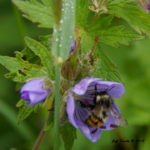 meadows of Mt. Roberts, this perennial has several common names, but most Juneauites refer to it as a Northern Geranium. Found in meadows, open woodlands and lower mountain elevations, this pink to purple flower is edible and has several medicinal and cosmetic uses, including root tea for stomach ulcers, diarrhea and dysentery. Geraniums are popular with gardeners as decorative plants, but they are often a key ingredient in various cosmetic products, where they’re used for their oil. Geranium oil has cleansing and toning properties, and is great for oily skin, acne and eczema. We see this beauty often in the meadows on the lower reaches of Mt. Roberts during our Town, Tram and Timberline Trek excursion.
meadows of Mt. Roberts, this perennial has several common names, but most Juneauites refer to it as a Northern Geranium. Found in meadows, open woodlands and lower mountain elevations, this pink to purple flower is edible and has several medicinal and cosmetic uses, including root tea for stomach ulcers, diarrhea and dysentery. Geraniums are popular with gardeners as decorative plants, but they are often a key ingredient in various cosmetic products, where they’re used for their oil. Geranium oil has cleansing and toning properties, and is great for oily skin, acne and eczema. We see this beauty often in the meadows on the lower reaches of Mt. Roberts during our Town, Tram and Timberline Trek excursion.
Siberian Miner’s-Lettuce or Siberian Springbeauty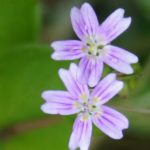 When gold prospectors arrived in Alaska aboard steamships, many were suffering with scurvy. Those who came before told new arrivals to eat this plant and are responsible for its common name. Quite tasty and juicy, Siberian Miner’s Lettuce offers abundant vitamin C to stave off the symptoms of scurvy. Sometimes known as Pink Purslane, the plant may be used as a lettuce or spinach substitute in salads. The leaves, stems, and flowers may all be eaten. All parts are high in vitamins A & C. True to its name, the attractive wild flower is a sign of spring and is found in the meadows of Mt. Roberts.
When gold prospectors arrived in Alaska aboard steamships, many were suffering with scurvy. Those who came before told new arrivals to eat this plant and are responsible for its common name. Quite tasty and juicy, Siberian Miner’s Lettuce offers abundant vitamin C to stave off the symptoms of scurvy. Sometimes known as Pink Purslane, the plant may be used as a lettuce or spinach substitute in salads. The leaves, stems, and flowers may all be eaten. All parts are high in vitamins A & C. True to its name, the attractive wild flower is a sign of spring and is found in the meadows of Mt. Roberts.

I’m amazed by how many of these flowers and plants are edible!